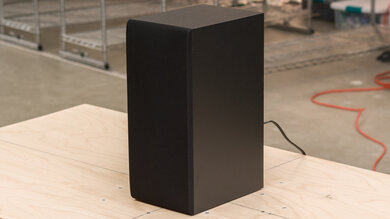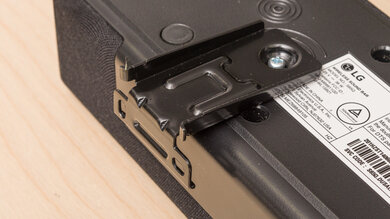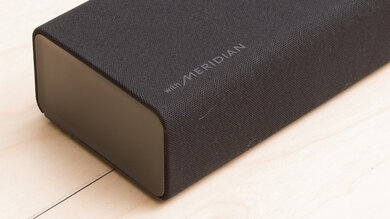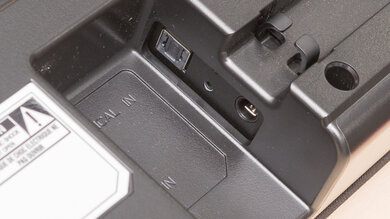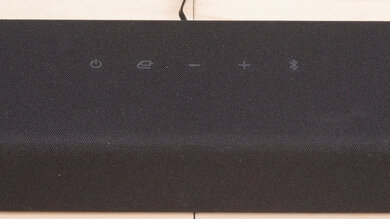The LG S65Q is a mid-range 3.1 setup released in 2022. It's a simple bar with a discrete center channel to improve vocal clarity with dialogue in movies and TV shows, and you don't have to worry about fitting satellite speakers into your living room. Unlike the 3.1.3 LG S80QY, there's no Dolby Atmos support. You won't find LG's higher-end features like AI Room Calibration or TV Sound Mode Share, either. However, there are still a wide range of features available, including lots of EQ presets such as 'Clear Voice' and 'AI Sound Pro'.
Our Verdict
The LG S65Q is decent for mixed usage. Out-of-the-box, dialogue is clear and present in the mix thanks to its balanced mids, and higher-pitched sounds are bright and sparkling. There's a little extra boom in the high-bass, and bass and treble adjustments to customize its sound. Unfortunately, you don't get the deep rumble in the low-bass with action-packed scenes and bass-heavy music. Its surround performance isn't very impressive, either, and there's no support for height content.
-
Bass and treble adjustments.
-
Dialogue enhancement feature.
-
Lacks low-bass.
-
No Dolby Atmos support.
The LG S65Q is good for dialogue-centric content like TV shows and podcasts. Since it's a 3.1 setup, there's a discrete center channel that reproduces dialogue with clarity and accuracy. You can also use its 'Clear Voice' mode to enhance voices, as well as a Night Time feature to balance the volume level when you don't want to disturb those around you. However, podcast listeners are limited to Bluetooth when it comes to wirelessly streaming to the bar.
-
Good center channel performance.
-
Dialogue enhancement feature.
-
No graphic EQ.
The LG S65Q is decent for music. In our subjective tests, we found the bar has a slightly v-shaped sound profile that adds extra boom in the high-bass, while higher-pitched vocals and instruments are bright and sparkling. The mids are still quite balanced, though, so lead instruments are clear and present in the mix. If you want a different sound, you're able to use its bass and treble adjustments to customize its sound. That said, it's not able to get the deep and rumbling low-bass in genres like EDM and hip-hop, unfortunately.
-
Bass and treble adjustments.
-
Gets loud.
-
No graphic EQ.
-
Lacks low-bass.
The LG S65Q is fair for movies. Dialogue is clear and present in the mix, though you don't feel the deep thump and rumble in action-packed scenes. It supports surround sound formats like Dolby Digital and DTS which are often found on streaming platforms, but it has to downmix it into stereo in order to play it. There's no Dolby Atmos support, either.
-
Bass and treble adjustments.
-
Gets loud.
-
Lacks low-bass.
-
No Dolby Atmos support.
- 7.0 Mixed Usage
- 7.7 Dialogue/TV Shows
- 7.1 Music
- 6.4 Movies
- Updated Nov 02, 2023: Added market comparison with the LG S77S in the Video Passthrough to TV box.
- Updated Jun 13, 2023: Converted to Test Bench 1.2. Updated the results for audio format support via ARC/eARC, HDMI In, and Optical. Added Video Passthrough to TV results as well.
- Updated Mar 20, 2023: Added cable lengths to In The Box.
- Updated Mar 16, 2023: Converted to Test Bench 1.1. With this update, we've added a Mounting test and added information aboutSubwoofer Output, Spotify Connect, and Microphone Mute.
- Updated May 20, 2022: Review published.
- Updated May 16, 2022: Early access published.
- Updated May 10, 2022: Our testers have started testing this product.
- Updated May 06, 2022: The product has arrived in our lab, and our testers will start evaluating it soon.
- Updated Apr 29, 2022: We've purchased the product and are waiting for it to arrive in our lab.
Differences Between Sizes And Variants
The LG S65Q is available in 'Black', and the label for our model is here.
If you come across another version of this soundbar, let us know in the discussions below so we can update our review.
Compared To Other Soundbars
The LG S65Q is a mid-range 3.1 model that doesn't support Dolby Atmos content. It's ideal for listening to vocal-centric content like TV shows thanks to its discrete center channel that improves vocal reproduction. However, it lacks low-bass and doesn't offer a very immersive sound with surround sound content.
See also our recommendations for the best soundbars, the best soundbars for dialogue, and the best LG soundbars.
The LG S75Q is better than the LG S65Q. The S75Q is a 3.1.2 setup, and it supports Dolby Atmos content found on lots of streaming platforms, unlike the S65Q. The 3.1 S65Q is still a solid pick for you if you just watch TV shows and music.
The LG SP8YA is better than the LG S65Q. The SP8YA is a 3.1.2 setup that supports Dolby Atmos content, unlike the S65Q. It's able to reproduce a more extended low-bass, too, and it has more premium features like room correction.
The LG S80QY is better than the LG S65Q. Unlike the S65Q, the S80QY supports Dolby Atmos content. It also comes with more sound enhancement features like room correction and more wireless playback options. It can reproduce a more extended low bass, so you feel more thump and rumble in your audio.
The Samsung HW-Q60C/Q6CC is a better 3.1 soundbar than the LG S65Q. The Samsung offers a more versatile overall performance, supporting Dolby Atmos content, which the LG lacks. It has a better stereo sound and a few more sound enhancement features to make the most of your listening experience.
The Samsung HW-Q60B is better than the LG S65Q. They're both 3.1 setups, but the Samsung supports Dolby Atmos content, unlike the LG. It also comes with a few more customization tools, including a graphic EQ.
The LG SP7Y is better than the LG S65Q. The SP7Y is a 5.1 setup that offers better soundstage and surround performances. It comes with more sound enhancement features, too. However, if you mostly listen to stereo content, the 3.1 S65Q is a solid choice.
The Samsung HW-Q600A is better than the LG S65Q. The Samsung is a 3.1.2 setup that supports Dolby Atmos content, unlike the LG. It has a more neutral sound profile out-of-the-box that reproduces clearer and more accurate dialogue.
The LG S77S is a better alternative to the LG S65Q. The S77S supports Dolby Atmos content, unlike the S65Q, so you can take advantage of more content on streaming services and Blu-rays. It has a more rounded design, too, which some users may prefer. Plus, it supports more resolutions and refresh rates for high-quality video passthrough, which is handy for gamers.
The Klipsch Cinema 700 is a better 3.1 setup than the LG S65Q. The Klipsch supports Dolby Atmos content, unlike the LG, and it has a better stereo soundstage. Also, it can reproduce a more extended low-bass. That said, it's not as well-built as the LG.
The LG SP9YA is better than the LG S65Q. The SP9YA is a 5.1.2 setup that supports Dolby Atmos content, unlike the S65Q. It's able to reproduce a more extended low-bass, too, and it has more premium features like room correction. Also, its surrounds and soundstage performances are better.
The Samsung HW-Q800A is better than the LG S65Q. The Samsung is a 3.1.2 setup that supports Dolby Atmos content, unlike the LG. It has a better stereo soundstage and a more neutral sound profile out-of-the-box that reproduces clearer and more accurate dialogue.
Test Results
The LG S65Q has a simple design. It's mostly made of plastic with fabric covering the top and the front, so it looks quite similar to the LG SP7Y.
The sub has a similar design to the sub for the LG SP7Y. It's mostly made of plastic with a wood-like material on the sides. The front is covered in fabric. When it's connected to the bar, a green light shines in the front, and you aren't able to turn it off or dim the brightness.
The LG S65Q has a good build quality. The bar is mostly made of plastic that feels solid. However, there's fabric on the front and top that collects dust and pet hair easily. The sub is also made of plastic, with a wood-like material on the sides. There's fabric in front, and it's nice and tight, especially compared to the fabric on the bar.
The LG S65Q has a decent stereo frequency response. Though the frequency response shows a more bass-heavy sound profile, with a little extra boom in the high-bass. The mids are quite balanced, so vocals and lead instruments are clear and present in the mix. Subjectively, it has a slightly v-shaped sound, with some extra brightness in the treble. However, it doesn't offer a very impressive low-frequency extension, so you don't feel the deep rumble in bass-heavy music genres.
With its bass set to '-5' and its treble set to '3', the LG S65Q has a more neutral frequency response. It's balanced across the range, so the bass is present, and vocals and lead instruments are clearly reproduced. Unfortunately, a bass adjustment feature can't make up for the low-frequency extension, so you still don't feel the thump in the low-bass.
The LG S65Q has a decent stereo soundstage. The soundstage is perceived to be a bit wider than the bar itself, but it doesn't have any tricks to make it seem wider than that. On the upside, it has good focus, so sound objects like instruments in an orchestra seem to come from an accurate location that matches the action onscreen.
The LG S65Q has a decent stereo dynamics performance. It gets loud, so you can fill up larger living rooms and open spaces with sound. However, at louder volumes, there's noticeable compression, especially in the bass range, that affects the clarity of audio. Bass-heavy music and action-packed scenes aren't as clear or detailed as a result.
The LG S65Q has a very good stereo THD performance. At normal listening volumes, audio reproduction is clean and pure. As with most bars, there's a jump in THD at max volume. You aren't likely to notice distortion unless you're an avid audiophile, and even then, it's only an issue at loud volumes.
The LG S65Q has a very good center channel performance. It's a 3.1 setup with a discrete center channel, so dialogue is clearly and accurately reproduced. Most voices are reproduced in the mid-range, and the channel's balanced frequency response ensures that they're present in the mix.
The LG S65Q has a poor surrounds performance. Since it's a 3.1 bar, it has to downmix surround sound into stereo in order to play it. As a result, sound objects - think voices or racing cars in a chase scene - don't seem to come from an accurate location in the soundstage. Instead, it seems like sound comes from speakers placed in front of you.
For a bar with Atmos support, check out the LG S75Q or the Samsung HW-Q60B.
The LG S65Q has a fair selection of sound enhancement features. Compared to more premium models like the LG S90QY and the LG S80QY, there's no room correction feature available, so it sounds a bit different depending on your room's acoustics. However, you still have some ability to customize its sound to your liking, using its bass and treble adjustments as well as its EQ presets: 'AI Sound Pro', 'Standard', 'Bass Blast', 'Music', 'Clear Voice', 'Game', 'Cinema', 'DTS Virtual:X', and 'Sports'. 'Clear Voice' enhances dialogue, and 'Cinema' and 'DTS Virtual:X' are virtual surround modes that provide a more three-dimensional sound.
You can connect the bar to your TV using traditional HDMI or Optical connections. However, if you have a compatible LG TV, you're also able to use LG Sound Sync to connect the bar to your TV wirelessly over a Bluetooth connection. It reduces the amount of wires in your setup, but if you don't have an LG TV, you only need one cable to connect the devices.
The LG S65Q has decent audio format support via ARC. It supports Dolby Digital, which you find on a lot of streaming services and Blu-rays, though it downmixes it into stereo. You aren't able to watch higher-quality formats like Dolby Atmos.
The LG S65Q has great audio format support via Full HDMI In. You can watch common surround sound formats, often found on streaming services. However, there's no support for lossless or object-based formats like Dolby Atmos.
The LG S65Q supports Dolby Digital via Optical, which is the most common surround sound format. DTS isn't as common on its own, but it's the fallback for DTS-HD MA, which is on a lot of Blu-rays.
The LG S65Q has a very good latency performance. It has fairly low latency, so you don't notice a delay between the audio you hear and the video you see. There's also an AV Sync feature in the app to help with any issues. Some TVs and apps compensate for latency differently, so your real-world experience can vary.
The LG S65Q is advertised to support 4k passthrough, but it can only do 1920 x 1080. A future firmware update may add high-quality passthrough capabilities, and we'll update the review if it does. You can always check out the LG S77S for a bar that can passthrough 4k @ 120Hz.
The LG S65Q lets you wirelessly stream audio to the bar from your mobile devices via Bluetooth.



